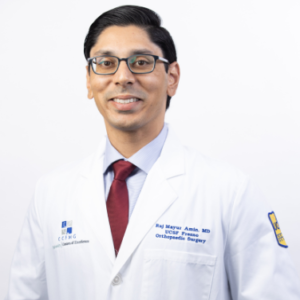News
Why I Chose to Specialize in Hip and Knee Arthritis Care
January 18, 2022
I’ll never forget the moment I knew I wanted to specialize in hip and knee arthritis surgery. I met a patient who was using a wheelchair because of the severity of his knee arthritis and deformity. He expressed deep disappointment that his disfigurement was deemed by others to be too complex for surgery. However, my attending physician at Johns Hopkins Hospital, Dr. Julius Oni, quickly said, “Raj, we can make a difference in this guy’s life.”
At the one-year post-operative appointment, I was able to speak with the patient who ended up as a great candidate for a double knee replacement. The patient I saw standing before me was a new person with a beaming, confident smile. While I enjoyed the complexity of his knee replacement, the vast improvement in his mental health and outlook on life was, without a doubt, more satisfying to witness as his doctor.
Before my experience with that patient, I always thought it’s just another hip or knee replacement. However, that patient perfectly captured the need for fellowship training in joint replacement. While training at Johns Hopkins Hospital, I operated with six joint replacement surgeons. In these experiences, I saw outstanding surgeons with a variety of different takes on the philosophies, indications, and techniques that guide primary joint replacement today. The words were dizzying—robotic, anterior-approach, minimally invasive, kinematic, and so on.
When it came time to select a fellowship training program, I wanted to attend a technology-forward institution. Stanford Hospital was the perfect opportunity to become familiar with robotic-assisted joint replacement. I am excited to help bring this technology to the patients of my hometown, in Fresno.
The robot provides a level of real-time objective data during the surgery that we’ve never had before—something especially critical in a nuanced surgery such as a partial knee replacement. While I still believe hip and knee replacement surgery is an art, the robot brings the information and insights we need to us earlier than ever before. This information is immediately available in the operating room, allowing us to adjust our plan in real-time rather than after surgery. As my fellowship attending physician often said, “You want it to be the Mona Lisa, every time.”
My inspiration for becoming an orthopaedic surgeon came from my late father, a psychiatrist in Fresno for 30 years. He instilled in me, through example, a need to focus on the minute details to improve the global care of the patient. Robotic joint replacement is one of many details to consider before, during, and after surgery—or even if surgery is indicated at all. As an orthopaedic surgeon specifically focused on hip and knee replacement, I look forward to diving deep into these small details. Collectively, I believe attention to these details add up to a significant difference in delivering comprehensive care and the best possible outcomes to the patients of the Central Valley.

Raj Amin, MD
About the Author: Raj Amin, MD, is a fellowship-trained orthopaedic surgeon who provides services at University Orthopaedic Associates. Dr. Amin holds a faculty appointment with University of California, San Francisco in the UCSF Fresno Department of Orthopaedic Surgery.
To learn more about Dr. Amin and University Orthopaedic Associates, click here.
